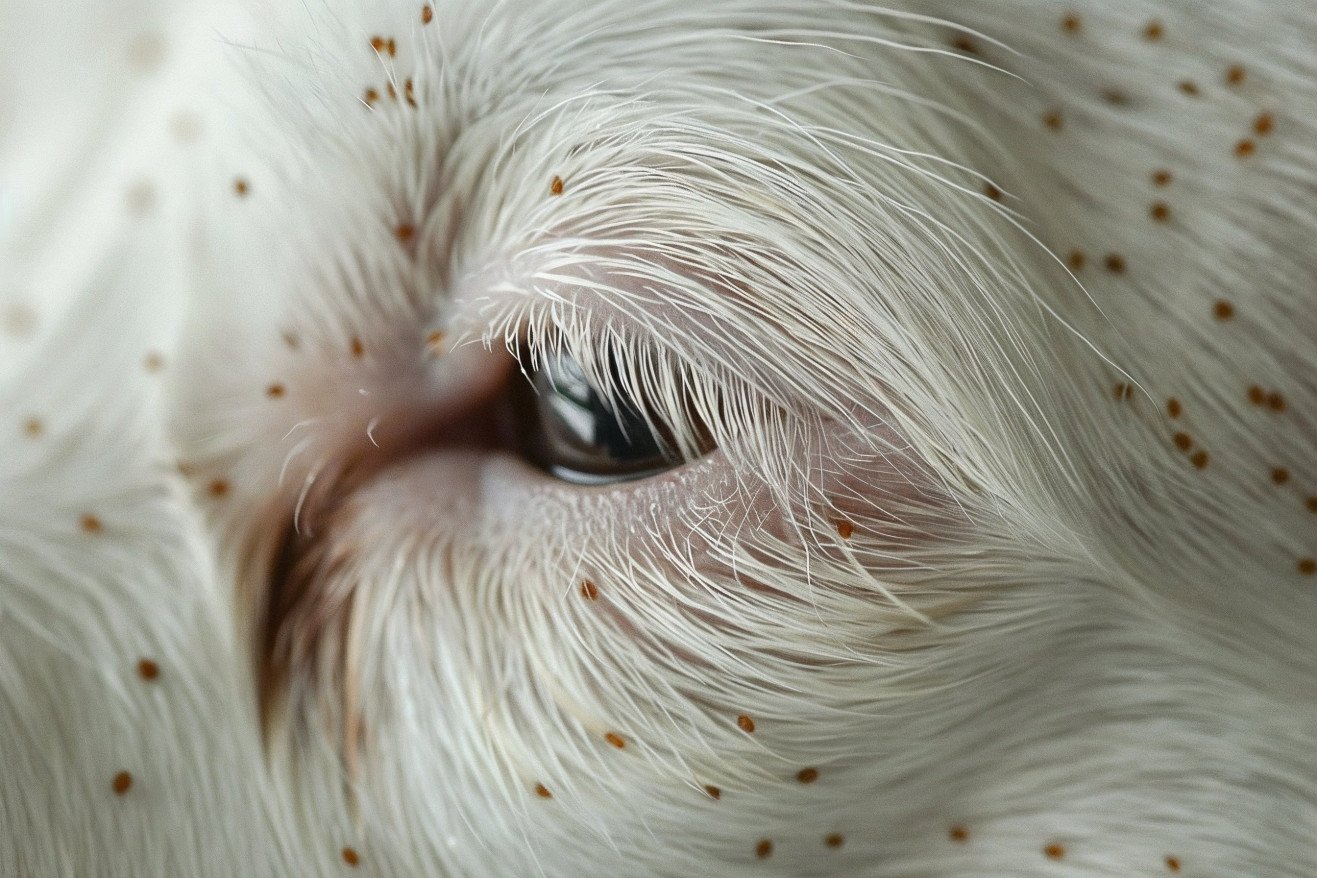What Do Dog Fleas Look Like? Identifying Fleas and Their Eggs
31 May 2024 • Updated 31 May 2024

If you've ever seen a bug on your dog and asked yourself "what do dog fleas look like?", you know that knowing what to look for in terms of their appearance and behavior is important when it comes to spotting an infestation. Dog fleas are small (about 1/8-inch long), reddish-brown bugs with a flat body that makes it easy for them to move through an animal's fur. They can be seen with the naked eye and look like small specks or dirt that moves on a pet or in an area where they live. Their bites cause small, red, itchy bumps on the skin.
To get a more in-depth look at what dog fleas look like and how to identify them, we'll go over visual information from veterinary and zoological research. This will allow us to see the morphological features and egg characteristics of fleas through both microscopic and macroscopic images. This will help you learn to identify the features of fleas, which is the first step in getting rid of a flea infestation in your home.
What do dog fleas look like to the human eye?
How to Spot Flea Eggs and Larvae
Flea eggs and larvae are often easier to spot than adult fleas, and they can be important clues that you have a flea infestation. Flea eggs are small, oval-shaped objects that are about the size of a grain of salt. They are white or off-white and have a smooth, sticky surface that helps them stick to the host animal and the surrounding environment, including bedding and carpet, according to The Vets.
When they hatch, flea larvae look like tiny, white or yellow worms that are about 1/4 inch long. The larvae are often easier to see than the adult fleas, and they can be a sign that you have a problem that needs to be addressed.
It takes about 2-14 days for flea eggs to hatch into larvae, and the warmer and more humid the environment, the faster this will happen. This means that in some areas, especially those with warm, humid climates, fleas can be a year-round problem. This makes it especially important to know what to look for in terms of flea eggs and larvae so you can catch an infestation early and prevent it from getting out of hand.
How to Tell if Your Pet Has Fleas
Flea bites will show up as small, red, itchy bumps on the skin of the host animal, according to the Falls Road Animal Hospital. Other signs of a flea infestation or an allergic reaction to flea saliva, which is called flea allergy dermatitis, include excessive scratching, hair loss, and skin irritation.
To confirm that your pet has fleas, check for adult fleas, flea dirt (feces), or eggs in their fur or in the areas where they sleep and spend time. Bond Vet also suggests a skin test or allergy test to rule out other skin conditions or allergies that could be causing the same symptoms.
In some cases, severe flea infestations can lead to anemia, which is especially dangerous for puppies and may require veterinary treatment. It’s important to treat the root cause of the problem to help your pet feel better and avoid other health issues.
How to Get Rid of Fleas on Pets and in the House
The first step to getting rid of fleas on your pet is to talk to your vet about the best flea control products, including topical or oral treatments. WebMD notes that you should ask your vet for a product that kills fleas at all stages of their life cycle and is effective in your specific area. It's also important to make sure that you're using the product on your pet every month to ensure that they're fully protected and to prevent future infestations.
To get rid of fleas in your home, it's important to vacuum your carpets, furniture, and other areas of your home regularly and thoroughly to remove fleas, eggs, and larvae. FRONTLINE explains that lapses in pet treatment can lead to flea infestations, so it's important to make sure that you're vacuuming your home frequently and consistently. In addition, washing your pet's bedding in hot, soapy water at least once a week, as suggested by Terminix, can help ensure that any remaining fleas are killed.
Bathing your pets with pet-friendly shampoos can also help remove fleas from their bodies, while keeping your yard well-maintained by mowing, removing debris, and using flea-repelling plants or nematodes can help keep outdoor flea populations in check, according to the RSPCA. A combination of treatments that target pets and the home is the best way to get rid of a flea infestation.
How to Prevent Fleas
The flea life cycle includes four stages: eggs, larvae, pupae, and adults, according to the Centers for Disease Control. The length of the life cycle can range from two weeks to several months, depending on environmental factors such as temperature and humidity.
Preventing future infestations can be achieved by treating pets regularly with products that disrupt the life cycle. While some products only kill adult fleas, others also prevent eggs from hatching into larvae, which is important for breaking the cycle, according to FRONTLINE. It's important to note that pet treatments should be combined with cleaning and environmental control to be most effective, according to Healthline's guide.
Knowing the flea life cycle and using products that target each stage can help ensure that pets and their owners don't have to deal with fleas.
Conclusion: How to Prevent and Control Flea Infestations
The first step in controlling flea infestations is to talk to your vet about the best flea control products for your pet, including topical or oral treatments. WebMD suggests asking your vet for a product that kills fleas at all stages of their life cycle and that is effective in your specific climate. It's also important to make sure that you stay on top of monthly dosing to ensure that your pet is always protected and that you don't have to deal with another infestation.
In addition to pet treatments, it's also important to vacuum your home frequently and thoroughly to remove fleas, eggs, and larvae from your carpets, furniture, and other surfaces. FRONTLINE explains that gaps in pet treatment can lead to flea infestations, so it's important to make sure that you're keeping up with your vacuuming schedule. In addition, washing your pet's bedding in hot, soapy water at least once a week, as suggested by Terminix, can help ensure that any remaining fleas are killed.
Bathing pets with pet-safe shampoos can also help control flea infestations, while maintaining your yard by mowing, removing debris, and using flea-repelling plants or nematodes can help keep outdoor flea populations in check, according to the RSPCA. Regular grooming, cleaning, and monitoring can help you make sure that your pet and your home remain free of fleas.


